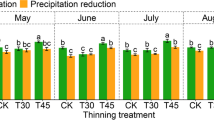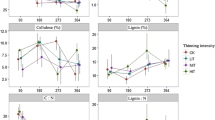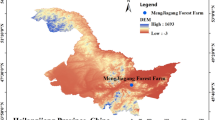Abstract
To engage sustainable forest management, understanding the impact of disturbances on the stability of soil microorganisms is important. This study reported the immediate effects of two-level thinning intensities on the soil microbial population, community composition and functions of a plantation forest over two years. Results showed that the thinning of Cryptomeria japonica forest significantly increased viable counts of soil bacteria from 7.7 × 106 to 1.4 × 107 or 1.6 × 107 in the 3rd month and the effect subsided in the 6th month post-thinning. The counts of actinobacteria, cellulolytic, nitrogen-fixing and phosphate-solubilizing bacteria groups maintained stable populations in the forest soils. Denaturing gradient gel electrophoresis profiles indicated that soil bacterial communities significantly differed among 25% thinning, 50% thinning and control treatment from the 12th to 18th month post-thinning, with no significant differences after 22 months. The community level physiological profiles were significantly different between control and thinning treatments in the 12th month post-thinning, the impacts of thinning then subsided by the 22nd month post-thinning as well. Soil bacteria were sensitive to thinning disturbances, but with resilience, their community and function approached to the control status in 2 years. This study demonstrates that the soil microbes of Taiwanese C. japonica forests are very sensitive to thinning disturbances, but recover stability after a relatively short period of time.




Similar content being viewed by others
References
Barbhuiya AR, Arunachalam A, Pandey HN, Khan ML, Arunachalam K, Khan ML, Nath PC (2004) Dynamics of soil microbial biomass C, N and P in disturbed and undisturbed stands of a tropical wet-evergreen forest. Eur J Soil Biol 40:113–121
Barbhuiya AR, Arunachalam A, Pandey HN, Khan ML, Arunachalam K (2008) Effects of disturbance on fine roots and soil microbial biomass C, N and P in a tropical rainforest ecosystem of Northeast India. Curr Sci 94:572–574
Bennett JA, Maherali H, Reinhart KO, Lekberg Y, Hart MM, Klironomos J (2017) Plant-soil feedbacks and mycorrhizal type influence temperate forest population dynamics. Science 355:181–184
Cantrell SA, Molina M, Lodge DJ, Rivera-Figueroa FJ, Ortiz-Hernández ML, Marchetti AA, Cyterski MJ, Pérez-Jiménez JR (2014) Effects of a simulated hurricane disturbance on forest floor microbial communities. For Ecol Manag 332:22–31
Chapin FS III, Matson PA, Mooney HA (2002) Terrestrial decomposition. In: Chapin MC (ed) Principles of terrestrial ecosystem ecology. Springer, New York, pp 152–155
Chatterjee A, Vance GF, Pendall E, Stahl PD (2008) Timber harvesting alters soil carbon mineralization and microbial community structure in coniferous forests. Soil Biol Biochem 40:1901–1907
Cho ST, Tsai SH, Ravindran A, Selvam A, Yang SS (2008) Seasonal variation of microbial populations and biomass in Tatachia grassland soils of Taiwan. Environ Geochem Health 30:255–272
Chuang CC, Kuo YL, Chao CC, Chao WL (2007) Solubilization of inorganic phosphates and plant growth promotion by Aspergillus niger. Biol Fert Soils 43:575–584
Chung MY, Lai CM, Ke GR, Wang PH, Wang MK (2013) Effects of thinning intensity of plantation forest on soil enzyme activities and soil functional diversity. Taiwanese J Agric Chem Food Sci 51:216–222
Clark KR, Warwick RM (2001) Change in marine communities: an approach to statistical analysis and interpretation. Primer-E Ltd., Plymouth
Connell L, Redman R, Craig S, Rodriguez R (2006) Distribution and abundance of fungi in the soils of Taylor Valley, Antarctica. Soil Biol Biochem 38:3083–3094
Cookson WR, O’Donnell AJ, Grant CD, Grierson PE, Murphy DV (2008) Impact of ecosystem management on microbial community level physiological profiles of postmining forest rehabilitation. Microb Ecol 55:321–332
Delvasto P, Valverde A, Ballester A, Igual JM, Muñoz JA, Gonzàlez F, Blàzquez ML, García C (2006) Characterization of brushite as a re-crystallization product formed during bacterial solubilization of hydroxyapatite in batch cultures. Soil Biol Biochem 38:2645–2654
Drigo B, Pijl AS, Duyts H, Kielak AM, Gamper HA, Houtekamer MJ, Boschker HTS, Bodelier PLE, Whiteley AS, van Veen JA, Kowalchuk GA (2010) Shifting carbon flow from roots into associated microbial communities in response to elevated atmospheric CO2. Proc Natl Acad Sci 107:10938–10942
Fan KH, Kuo YL (2010) Effects of thinning management on emission of soil CO2 flux of Cryptomeria japonica plantations. In: Proceedings of symposium on influences of plantation thinning on biodiversity and ecosystem function, Taiwan Forestry Research Institute, Taipei, pp 29–43
Fell JW, Scorzetti G, Connell L, Craig S (2006) Biodiversity of microeukaryotes in Antarctic Dry Valley soils with <5% soil moisture. Soil Biol Biochem 38:3107–3119
Fenchel T, Finlay BJ (2004) The ubiquity of small species: patterns of local and global diversity. Bioscience 54:777–784
Garland JL, Mills AL (1991) Classification and characterization of heterotrophic microbial communities on the basis of patterns of community-level-sole-carbon-source-utilization. Appl Environ Microbiol 57:2351–2359
Girisha GK, Condron LM, Clinton PW, Davis MR (2003) Decomposition and nutrient dynamics of green and freshly fallen radiata pine (Pinus radiata) needles. For Ecol Manag 179:169–181
Governo R, Lockaby BG (2004) Silvicultural management within streamside management zones of intermittent streams: effects on decomposition, productivity, nutrient cycling, and channel vegetation. South J App For 28:211–224
Grady KC, Hart SC (2006) Influences of thinning, prescribed burning, and wildfire on soil processes and properties in southwestern ponderosa pine forests: a retrospective study. For Ecol Manag 234:123–135
Grayston SJ, Rennenberg H (2006) Assessing effects of forest management on microbial community structure in a central European beech forest. Can J For Res 36:2595–2604
Hannam KD, Quideau SA, Kishchuk BD (2006) Forest floor microbial communities in relation to stand composition and timber harvesting in northern Alberta. Soil Biol Biochem 38:2565–2575
Hartmann M, Niklaus PA, Zimmermann S, Schmutz S, Kremer J, Abarenkov K, Lüscher P, Widmer F, Frey B (2014) Resistance and resilience of the forest soil microbiome to logging-associated compaction. ISME J 8:226–244
Haynes RJ (2005) Labile organic matter fractions as central components of the quality of agricultural soils: an overview. Adv Agron 85:221–268
Houston APC, Visser S, Lautenschlager RA (1998) Microbial processes and fungal community structure in soils from clear-cut and unharvested areas of two mixed wood forest. Can J Bot 76:630–640
Hsieh TH (2010) Effect of thinning management on understory layer of Cryptomeria japonica plantations. In: Proceedings of symposium on influences of plantation thinning on biodiversity and ecosystem function, Taiwan Forestry Research Institute, Taipei, pp 45–51
Johnson LF, Curl EA (1972) Methods for research on the ecology of soil-borne plant pathogens. Burgess Publishing Company, Minneapolis
Kara O, Bolat I, Cakiroglu K, Ozturk M (2008) Plant canopy effects on litter accumulation and soil microbial biomass in two temperate forests. Biol Fertil Soils 45:193–198
Knelman JE, Schmidt SK, Lynch RC, Darcy JL, Castle SC, Cleveland CC, Nemergut DR (2014) Nutrient addition dramatically accelerates microbial community succession. PLoS ONE 9:e102609
Li H, Zhang Y, Li DS, Xu H, Chen GX, Zhang CG (2009) Comparisons of different hypervariable regions of rrs genes for fingerprinting of microbial communities in paddy soils. Soil Biol Biochem 41:954–968
Lin WR, Wang PH, Chen MC, Kuo YL, Chiang PN, Wang MK (2015) The impacts of thinning on the fruiting of saprophytic fungi in Cryptomeria japonica plantations in central Taiwan. For Ecol Manag 336:183–193
Lin WR, Wang PH, Chen WC, Lai CM, Winder RS (2016) Responses of soil fungal population and community to the thinning of Cryptomeria japonica forests. Microbes Environ 31:19–26
Ludovici KH, Kress LW (2006) Decomposition and nutrient release from fresh and dried pine roots under two fertilizer regimes. Can J For Res 36:105–111
Maassen S, Fritze H, Wirth S (2006) Response of soil microbial biomass, activities, and community structure at a pine stand in northeastern Germany 5 years after thinning. Can J For Res 36:1427–1434
Mackay SJ (1977) Improved enumeration of Streptomyces spp. on a starch casein salt medium. Appl Environ Microbiol 33:227–230
Meyer O (1994) Functional groups of microorganisms. In: Schultze ED, Mooney HA (eds) Biodiversity and ecosystem function. Springer, Berlin, pp 67–96
Meyer AF, Lipson DA, Martin AP, Schadt CW, Schmidt SK (2004) Molecular and metabolic characterization of cold-tolerant alpine soil Pseudomonas sensu stricto. Appl Environ Microbiol 70:483–489
Nannipieri P, Ascher J, Ceccherini MT, Landi L, Pietramellara G, Renella G (2003) Microbial diversity and soil functions. Eur J Soil Sci 54:655–670
Ohashi M, Gyokusen K, Saito A (1999) Measurement of carbon dioxide evolution from a Japanese cedar (Cryptomeria japonica D. Don) forest floor using an open-flow chamber method. For Ecol Manag 123:105–114
Rui JP, Peng JJ, Lu YH (2009) Succession of bacterial populations during plant residue decomposition in rice field soil. Appl Environ Microbiol 75:4879–4886
Schimel J (2016) Microbial ecology: linking omics to biogeochemistry. Nat Microbiol 1:15028
Smith NR, Kishchuk BE, Mohn WW (2008) Effects of wildfire and harvest disturbances on forest soil bacterial communities. Appl Environ Microbiol 74:216–224
Tortora GJ, Funke BR, Case CL (2007) Microbiology—an introduction. Pearson International Edition, California
Wang C, Xue L, Dong Y, Hou L, Wei Y, Jiao R (2019) Responses of soil microbial community structure to stand densities of Chinese fir plantations. J For Res 24:162–167
Weng SH, Kuo SR, Guan BT, Chang TY, Hsu HW, Shen CW (2007) Microclimatic responses to different thinning intensities in a Japanese cedar plantation of northern Taiwan. For Ecol Manag 241:91–100
Wu R, Cheng X, Han H (2019) The effect of forest thinning on soil microbial community structure and function. Forests 10:352
Zhou Z, Wang C, Ren C, Sun Z (2020) Effects of thinning on soil saprotrophic and ectomycorrhizal fungi in a Korean larch plantation. For Ecol Manag 461:117920
Zhuang SY, Chen YM, Wang MK, Kuo SR, Hwong JL, King HB (2005) Influences of forestry thinning on soil nitrogen mineralization and nitrification. Taiwan J For Sci 20:167–177 (in Chinese)
Zumsteg A, Luster J, Göransson H, Smittenberg RH, Brunner I, Bernasconi SM, Zeyer J, Frey B (2012) Bacterial, archaeal and fungal succession in the forefield of a receding glacier. Microbial Ecol 63:552–564
Acknowledgements
This project was supported by grants from the Taiwan Forestry Bureau, Taiwan (97-00-5-02, 98-00-5-31). We thank Dr. I-Fang Sun, Dr. Chih-Ming Chiu and Dr. Hen-Biao King for their role in setting up the dynamic plots; and Dr. Kuo-Ching Tzeng for his advice concerning Biolog.
Author information
Authors and Affiliations
Corresponding author
Rights and permissions
About this article
Cite this article
Lin, WR., Chen, WC. & Wang, PH. Soil microbial community is resilient to thinning disturbance. Trop Ecol 64, 62–71 (2023). https://doi.org/10.1007/s42965-022-00243-z
Received:
Revised:
Accepted:
Published:
Issue Date:
DOI: https://doi.org/10.1007/s42965-022-00243-z




